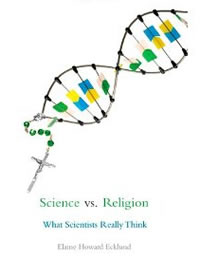Book Notes
 Elaine Howard Ecklund, Science vs. Religion; What Scientists Really Think (New York: Oxford University Press, 2010), 228pp.
Elaine Howard Ecklund, Science vs. Religion; What Scientists Really Think (New York: Oxford University Press, 2010), 228pp.
In this recent study, sociologist Elaine Howard Ecklund of Rice University moves beyond common cultural rhetoric to social scientific reality. During a four-year period from 2005–2008 she surveyed roughly 1,700 scientists from seven natural and social scientific disciplines who were randomly selected from twenty-one elite research universities. In addition, she further interviewed 275 of these scientists in person or by phone. She structures much of her narrative around ten scientists who embody many of the broad themes that emerged from the study.
"Neither a polemic nor a manifesto," she writes, "this book offers a balanced assessment of information gathered scientifically from scientists themselves" (p. 5), although in the last chapter she sheds her scientific neutrality and assumes the role of an "arbitrator" (p. 149) to suggest how both scientists and religionists can engage in "more productive dialogue." Ecklund's study documents how the common assumptions of many people are wrong.
In the first half of the book she explores the personal religious beliefs of scientists. About 53% of the elite scientists have no religious tradition, but this likewise means that almost half of them do subscribe to some sort of spirituality. Those who reject religion often do so for reasons that have nothing to do with science (eg, family background or the problem of evil). Roughly twenty percent of atheists and agnostics still describe themselves as "spiritual." In the second half of the book, Ecklund describes how these scientists engage public issues. How do they handle religion in the classroom? Do they actively suppress it, passively ignore it, or constructively enage it? Another chapter examines the secularization of the university. As a former campus minister, I especially enjoyed her chapter "God on the Quad" (40 percent of the scientists thought that "religion could play some positive role on university campuses").
This book should make for an excellent conversation starter among scientists and people of faith. You can give it to anyone in either group with the confidence that it is scientifically reliable, fair minded, and nuanced. Everyone gets to have their say in their own words (although the results are not always flattering). You learn why scientists distrust religion. Others talk about the rigid secular orthodoxy that they experience on campus, and how so-called "diversity" is often very limited. One unbeliever feared that science was doing itself much harm by its dismissive attitude toward religion. None of the scientists she surveyed supported the theory of intelligent design. One of the biggest problems is when both sides, because of their limited experiences of the other group, have no "cultural scripts" and so resort to shallow stereotypes. In a short, final chapter Ecklund tries to "shatter myths" that her study uncovered, like the myth that all atheists are hostile to religion, that there are no religious scientists, that religion will go away if you ignore or suppress it, or that all religion is fundamentalist. Three appendices conclude the book by describing the study, the survey, and the interviews in person and by phone.


